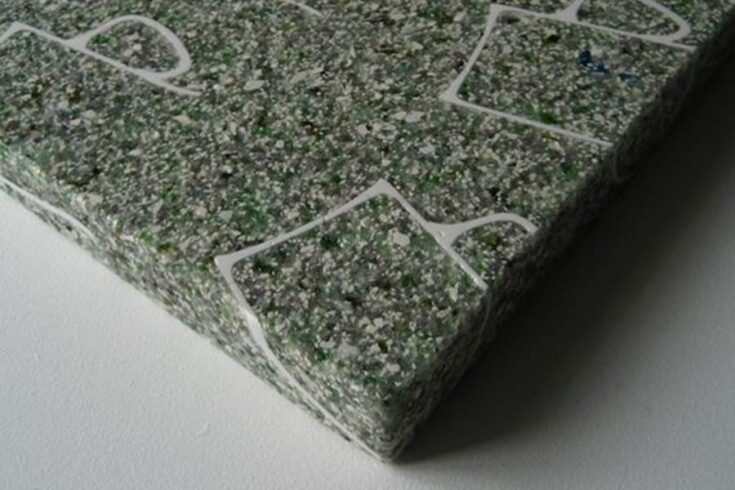The Aesthetic of Waste project was led by Professor David Binns and Dr Alasdair Bremner at the University of Central Lancashire’s Silicates Research Unit. It was driven by concerns about the environmental implications of excessive mineral consumption within the construction industry.
Funded in part by the Arts and Humanities Research Council (AHRC), the project involved combining a wide range of low-value waste materials such as recycled glass, ceramic and mineral waste, which are normally sent to landfill.
About the project
Binns and Bremner developed prototypes of a new, sustainable material which is suitable for use in everything from cladding to counter surfaces. The new material is made from at least 98% recycled waste, is more environmentally sound in its production methods than traditional ceramic, and can be recycled at the end of its life.
Binns’ and Bremner’s unique process forms a revolutionary new climate-friendly material which combines the functionality and surface possibilities of ceramic and stone, and is aesthetically comparable to traditional materials. It has also been fully certified by the British Standards Association.
Impacts of the project
Follow-on funding from AHRC in 2013 enabled Binns and Bremner to pilot a commercialisation model of the product and establish Alusid Ltd in 2014. With the support of the grant, the pair partnered with IP Frontier to secure £260,000 in venture capital funding to set up the proof-of-concept manufacturing plant.
The company now produces a range of products, supplying materials and furniture to the hospitality, corporate and healthcare sectors in businesses such as hotel group Four Seasons’ Coya restaurants and Nando’s headquarters.
Binns’ and Bremner’s patented research bridges design, industrial manufacturing, craft and art practice, offering considerable environmental, economic, creative and social impacts.
Environmental benefits
Recent developments have addressed the recycling of cathode ray tube (CRT) glass containing lead, currently designated as hazardous waste and presenting a major problem for the global recycling industry. By incorporating CRT glass into the newly-developed material, the lead content is safely encapsulated, allowing CRT glass to be re-classified as a safe raw material.
Social impact
Since its launch in 2015, Alusid has won numerous design and industry awards across the UK and beyond. The company’s materials recently featured in a major new exhibition at the Design Museum which explored how design can tackle throwaway culture.
Skills development
Working in partnership with Recycling Lives, a commercial recycling company, Alusid offered employment and training opportunities for three to four apprentices through the Pathway to Independence Scheme. The aim was to develop their transferable skills and, potentially, hire them as full-time employees as the business grows.
Find out more
Read more about the outcome of Binns and Bremner’s work on the Alusid website.
Read their paper The Aesthetic of Waste – an investigation of the creative and commercial potential of kiln cast recycled mineral waste on Gateway to Research.
Top image: Tableware cast made of waste materials. Credit: David Binns.

